![]()
![]()
![]()
Use LEFT and RIGHT arrow keys to navigate between flashcards;
Use UP and DOWN arrow keys to flip the card;
H to show hint;
A reads text to speech;
22 Cards in this Set
- Front
- Back
- 3rd side (hint)
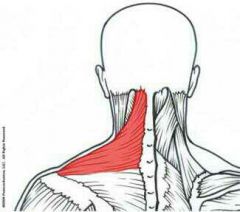
Trapezius (upper) |
O= External occipital protuberance, medial third of superior nuchal line of occipital bone, ligamentum. nuchae, spinous processes of C6-T12 I= Lateral third of clavicle, acromion process, and spine of the scapula. A= Scapular elevation and upward rotation, assist in retraction of scapula. N= Spinal accessory (cranial nerve [CN] XI) C2,C3,C4 sensory component. |
Function: Raises and lowers the shoulders and shrug them (more vertical line of pull) |
|
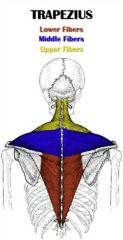
Trapezius (middle) |
O= Spinous processes of C7-T3 I= Scapular spine A= Scapular retraction (adduct) N= Spinal accessory (CN XI) C3, C4 sensory component |
Function: Squeeze shoulder blades together and stabilize scapula; (horizontal line of pull makes it very effective at scapular retraction) |
|
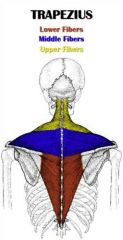
Trapezius (lower) |
O= Spinous processes of middle and lower thoracic vertebrae T4-T12. I= Base of scapular spine A= Scapular depression and upward rotation; assist in retraction. N= Spinal accessory (CN XI) C3, C4 sensory component. |
Function: It's diagonal line of pull is more downward(vertical), depress and upward rotate scapula. |
|

Levator Scapulae |
O= Transverse processes of first four cervical vertebrae. I= Vertebral border of scapula (between the superior angle and spine). A= Scapular elevation and downward rotation. N= Third and Fourth cervical nerves and dorsal scapular nerve (C5). |
Function: Elevates and retracts the scapula and abduct the neck (diagonal line of pull is mostly vertical) |
|
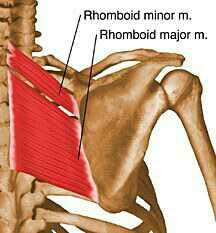
Rhomboid minor |
O= Spinous processes of C7-T1 vertebrae. I= Medial border of scapula near the level of the spine, superior to rhomboid major. A= Retracts the scapula and rotates it to depress the glenoid cavity; fixes scapula to thoracic wall (scapulothoracic articulation). N= Dorsal scapular nerve(C4, C5). |
Function: Retracts, rotates, and fixes the scapula. |
|
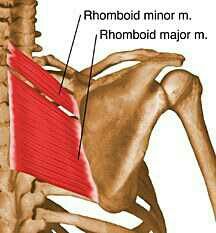
Rhomboid major |
O= Spinous processes of T2-T5 vertebrae. I= Medial border of scapula near the level of the spine to the inferior angle. A= Retracts the scapula and rotates it to depress the glenoid cavity; fixes scapula to thoracic wall (scapulothoracic articulation ). N= Dorsal scapular nerve (C4, C5). |
Function: Retracts, rotates, and fixes the scapula. |
|
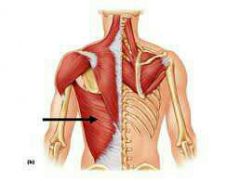
Latisimus Dorsi |
O= Spinous process T7-L5 (via dorsolumbar fascia); posterior surface of sacrum, iliac crest and lower 3 ribs. I= Bicipital (intertubercular) groove of humerus (medial floor) A= Extension, hyperextension, adduction, and medial (internal) rotation. N= Thoracodorsal nerve (C6,C7,C8). |
|
|
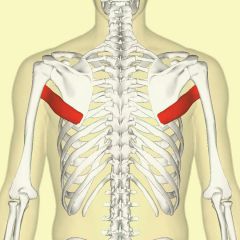
Teres Major |
O= Axillary border (scapula) near the inferior angle. I= Crest below the lesser tubercle. A= Shoulder extension, medial rotation, and adduction. N= Lower scapular nerve (C5, C6, C7) |
|
|
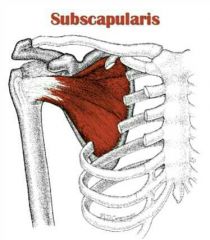
|
O= Subscapular fossa(scapula). I= Lesser tubercle (humerus) A= Shoulder medial rotation; and adduct the arm to help hold the humerus head in glenoid cavity. N= Upper & lower subscapular nerves (C4, C6) |
|
|
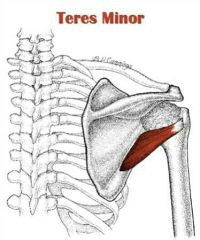
|
O= Axillary border (scapula). I= Greater tubercle (humerus). A= Shoulder lateral rotation and horizontal abduction. N= Axillary nerve (C5, C6). |
|
|

|
O= Infraspinous fossa (scapula). I= Greater tuburcle (humerus). A= Shoulder lateral rotation and horizontal abduction. N= Suprascapular nerve (C5, C6). |
|
|
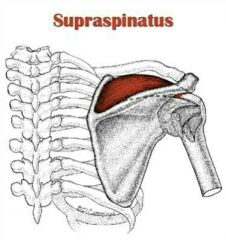
Supraspinatus |
O= Supraspinous fossa (scapula). I= Greater tubercle(humerus). A= Shoulder abduction. N= Suprascapular nerve (C5, C6). |
|
|
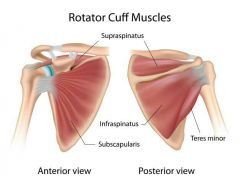
Rotator Cuff Muscles |
•Supraspinatus •Infraspinatus •Teres Minor •Sunscapularis |
|
|
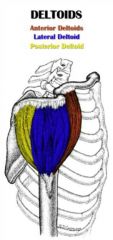
Middle (Lateral)Deltoid |
O= Acromion Process. I= Deltoid tuberosity. A= Shoulder abduction. N= Axillary nerve (C5, C6). |
|
|
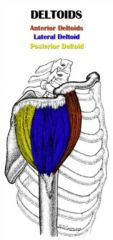
Posterior Deltoid |
O= Spine of scapula. I= Deltoid tuberosity. A= Shoulder extension, hyperextension, abduction, horizontal abduction, lateral (external) rotation. N= Axillary nerve (C5, C6 ). |
|
|
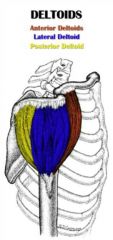
Anterior Deltoid |
O= Lateral third of clavicle. I= Deltoid tuberosity. A= Shoulder flexion, abduction, horizontal adduction, and medial rotation. N= Axillary nerve (C5, C6) |
|
|
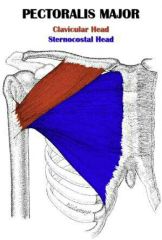
|
O= Sternal costal cartilage of first six ribs. I= Lateral lip of bicipital groove of humerus. A= Shoulder extension (1st 60°) from 180° to 120°. N= Lateral & medial pectoral nerve (C5, C6, C7, C8, T1). |
|
|
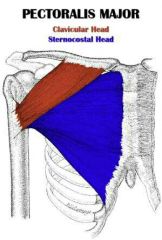
Pectoralis Major (clavicular & sternal portions) |
A= Shoulder adduction, horizontal adduction, medial rotation. N= Lateral & Medial pectoral nerve (C5, C6, C7, C8, T1). |
|
|

Pectoralis Major (clavicular portion) |
O= Medial third of clavicle. I= Lateral lip of bicipital groove of humerus. A= Shoulder flexion (1st 60°). N= Lateral & medial pectoral nerve (C5, C6, C7, C8, T1). |
|
|
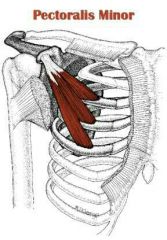
Pectoralis Minor |
O= Anterior surface of ribs 3-5. I= Coracoid process of scapula. A= Scapular depression, protraction, downward rotation and tilt. N= Medial pectoral nerve (C8, T1) |
Function: pulls the shoulder girdle down and forward; elevate the thorax during forced inhalation. The muscle is on the anterior surface while the scapula moves on the posterior surface. |
|
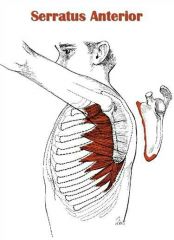
Serratus Anterior |
O= Lateral surface of the upper 8 ribs (1-8). I= Vertebral (medial) border of the scapula anterior surface. A= Scapular protraction, upward rotation. N= Long thoracic nerve (C5, C6, C7) |
Function: allows forward rotation of the arm and to pull scapula around the rib cage; upward rotation allowing abduction of the arm. |
|
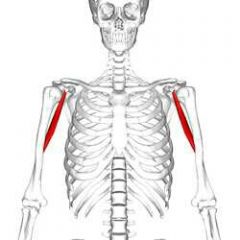
Coracobrachialis |
O= Coracoid process(scapula). I= Medial surface of humerus (midpoint). A= Stabilize the shoulder joint; Assist in shoulder flexion and medial rotation. N= Musculocutaneous nerve (C6, C7). |
Lies deep to the biceps brachii. |

